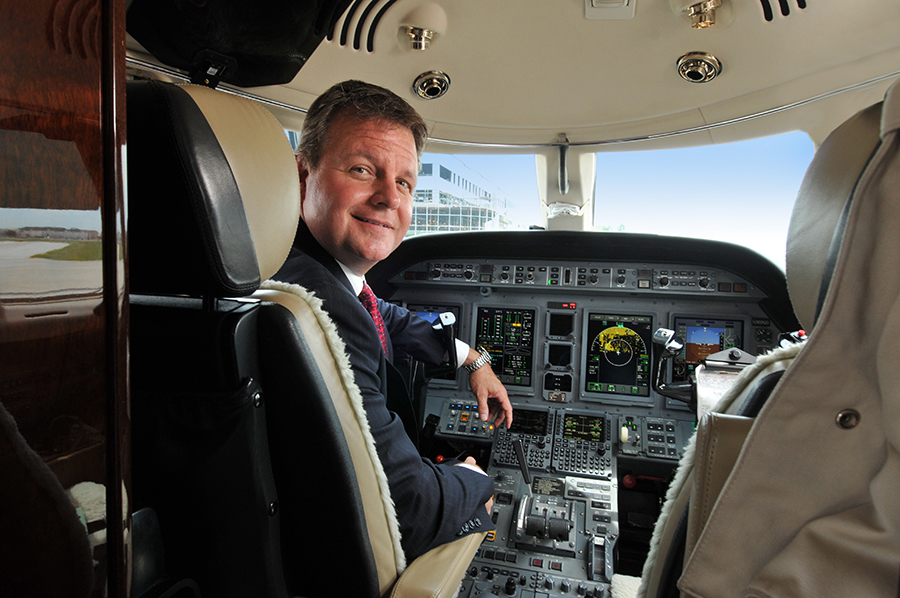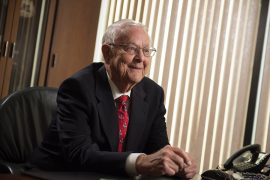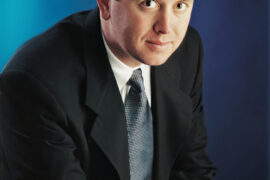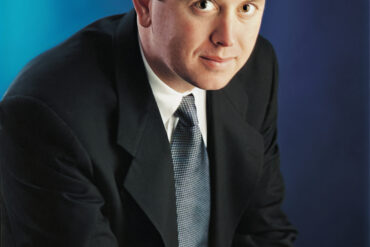Huntington native Bill Noe has gone from a speedster in the swimming pool to a shark in the boardroom as president and chief operating officer of NetJets North America.
By Jack Houvouras
HQ 77 | SPRING 2012
When he was just 4 years old, little Billy Noe was swimming with some other children at Huntington’s Olympic Pool when, off in the distance, he eyed the high-diving platform hovering some 16 feet over the deep end. He decided to give it a try – so he marched the length of the pool, climbed the ladder, walked to the edge and hurled himself toward the water. As his body was flying through the air, whistles began screeching from down below as lifeguards tried in vain to stop the youngster from jumping from such an imposing height. They immediately dove into the water to fish him out of the deep end but once again were too late, as Billy zipped across the water and casually climbed out of the pool on his own. That summer day at the Olympic Pool would be the first sign of the steely resolve he would use to propel himself to the highest levels of success as both an athlete and a businessman.
Bill Noe, now 47, has always been high reaching. The former standout swimmer for the Huntington YMCA and Marshall University is today the president and chief operating officer of NetJets North America, a pioneering company with the largest fleet of private jets in the world. Warren Buffet, the renowned billionaire, was a NetJets customer for three years before he decided to buy the company in 1998.
NetJets, originally founded in 1964 as Executive Jet, implemented a unique business model starting in 1986 that would change the way some of the world’s biggest movers and shakers fly. The concept is called fractional ownership. Instead of buying their own private jet, individuals purchase a share of a plane.
Depending on the size of their share, they are guaranteed access to the jet for a certain number of hours or days each year. If owners need to fly somewhere, they simply call NetJets, and the plane and flight crew will arrive at their local airport within four hours. Owners also have the option of selling their share back to the company or to another individual.

“Our business is getting people on a jet, taking them where they want to go and having it be a pleasant experience,” Noe explains. “It’s also about giving them that ‘wow’ factor. That’s what we do. Our customers include some of the most famous people in the world. Of course I can’t name names, but there aren’t many celebrities we haven’t flown.”
The story of how Bill Noe made his way from the deep end of Huntington’s Olympic Pool to the corner office at the NetJets world headquarters in Columbus, Ohio, is compelling. And, like most success stories, it is a study in hard work, determination, passion and fate.
Born in Ashland, Ky., Noe and his family moved to Huntington when he was 1 and lived in an apartment across the street from the Frostop Drive In. At the time his father, William E. Noe Sr., was a milkman, and his mother, Francis A. Noe, was a nursing student. The family grew once more with the addition of a daughter, Stephanie, who was born four years later.
Noe’s daring leap from the high dive at the Olympic Pool that hot summer day caught the attention of not only the lifeguards, but also Huntington YMCA Swim Team Coach Bob Shaw. Shaw approached the young boy and asked him if he would like to try competitive swimming. Not long afterwards – at the ripe age of 5 – Noe began his long career in the pool. He took to water like a moth to a flame and won nearly every race he entered in a trend that would continue for 14 years.
“I always loved the water and I loved to compete,” Noe says of his years swimming. “Although it’s a team sport, it’s all up to the individual as to how well they perform. For me, racing the clock was everything.”

Noe attended kindergarten at Enslow Park Presbyterian Church before moving on to Cammack Elementary, Cammack Junior High and St. Joseph High School. He was a fair student, but the rigors of swimming took up most of his time. It was not uncommon for Noe to be in the pool each day from 5:30 a.m. to 6:30 a.m. before school, and from 4:30 p.m. to 6:30 p.m. after school.

The Noe family eventually moved from their small apartment to a nice home high atop a hill near the Huntington Museum of Art. Noe’s father was now a successful salesman for Ohio Medical Products, which later became Ohmeda Medical. His mother had graduated from St. Mary’s School of Nursing and was now working as an anesthetist.
“I learned about work ethic by watching my parents,” Noe explains. “My dad would leave on Monday and come back on Friday. My mom would often leave for work at 4 a.m. and was the kind of person who never said no if somebody needed a shift filled. The one person I really looked up to was my father. He reminded me of John Wayne – he was very tough, but he had a soft side. He was the kind of person who could say anything to someone and they’d smile. People loved him. You can’t learn that kind of charisma.”
In the pool, Noe was a sprinter who excelled in every event. By the time he reached the first grade, he was breaking pool, city and state records. In fact, he still holds the state record for the 200 Freestyle, which he set in 1975 as a 9/10 year old. His talent took him to national meets around the country where he often finished near the top.
During his senior year of high school, Noe qualified for several events at the YMCA Nationals held in Ft. Lauderdale, Fla. He placed in every race he entered, but his best chance for winning a national title came in the 200 Butterfly. Entering the race he was the No. 2 seed. As he walked to the starting block he looked over at the No. 1 seed, a young man named Duffy Dillon, and felt a surge of confidence. Noe, who was a very muscular, barrel-chested athlete, towered over the diminutive swimmer.
“The kid was short and skinny and I remember thinking, ‘This guy doesn’t have a chance.’ But he beat me, and I’ll never forget it,” Noe laments.
Noe’s second-place finish in the event, and numerous other top 10 performances at the meet, capped off a stellar senior season. After fielding scholarship offers from several colleges including Ohio State, he ultimately decided to stay in Huntington and swim for Marshall University’s charismatic coach, Bob Saunders.
“Bill was one of the most exciting recruits we ever had in our program,” Saunders says. “He was being wooed by a lot of big-time colleges and we were afraid we wouldn’t get him. He was an outstanding talent and we were thrilled when he chose Marshall. Bill was so versatile that we could use him in nearly any race. He was such an easygoing kid and never caused me any problems. He is certainly one of the greatest swimmers Huntington has ever produced.”
Noe peaked as an athlete during his freshman year at Marshall. As was often the case during his swimming career, he coasted through the regular season, always finishing near the top of his events. But when the time came for the biggest meet of the year, usually held at the end of the season, he shifted into another gear. He trained harder and his focus intensified. As a result, records often fell.
Such was the case entering the 1983 Southern Conference Swimming Championship held in the aquatics arena at Marshall’s Cam Henderson Center. To prepare for the big event, Noe and his teammates shaved their heads and bodies as a way to reduce their drag in the water. It worked. Noe set six pool, six school and six conference records while leading the Thundering Herd to the Southern Conference Championship.Healsowonthe championship’s “Most Valuable Swimmer” award.
“That is something I will never forget,” Noe reflects. “I was very proud to be a collegiate athlete for Marshall University, and I still am.”
While Noe may have been proud of his record-setting performances at the 1983 Southern Conference Championship, he doesn’t mention that or any other event in the pool as the highlight of his swimming career. Instead, he points to a moment during his junior year of college, when something far more important was at stake. While on vacation in Myrtle Beach, S.C., with a group of friends, Noe was thrust into the national spotlight when a teenager tried to commit suicide.
“I was in the hotel room taking a shower before dinner when someone started pounding on the door, telling me to get out right away,” Noe recalls. “One of my friends told me a kid was trying to kill himself by swimming out to sea. Apparently his girlfriend had cheated on him and he thought his life was over. I looked out over the balcony, and a small crowd was gathering at the beach.”
At that point, one of Noe’s friends looked at him and said casually, “Go get him.” Noe grabbed his swim trunks and ran downstairs and out the door. By the time he reached the water, there were a handful of people on rafts trying to catch up to the young man, but the ocean was choppy and they weren’t making much progress. Noe dived into the water and began slicing through the waves in the direction of the young man. When he was approximately one mile from shore, he lost sight of the swimmer and looked back to the crowd, who pointed him in the right direction. Noe swam another half-mile out and again looked back to the crowd for direction. But by now it was near dusk, and he could no longer see the shore. Somehow he managed to find the young man, who was in serious trouble.
“He was about to go under,” Noe recalls. “He was starting to take in water.”
After negotiating with the young man for several minutes, Noe finally grabbed him and held onto him until a windsurfer appeared. He then threw the teen onto the windsurfer’s board, and the three waited until the Myrtle Beach Search and Rescue team arrived. After pulling the young man aboard, the rescue team informed Noe that their boat was over capacity. They then threw him a raft and told him they would return for him shortly. But Noe didn’t feel like waiting around and paddled easily back to shore. He then walked inside, got dressed and went out to dinner with his friends. Two days later, Noe received a call from his father in Huntington who asked, “Did you save some kid’s life in Myrtle Beach?” His father had received a call from a local reporter after the story was picked up by the Associated Press.
“I don’t know how the press got my name,” Noe says. “I guess one of my friends must have told them. The next day the kid came to our hotel room and said, ‘I just want to thank you. I had too much to drink and was doing something stupid. I just really appreciate what you did.’ I got a letter from his parents afterwards. I never saw him again. I sometimes wonder if all those years in the pool were preparation for that day.”
Bill Noe was at a crossroads after his junior year at Marshall. He was burned out in the pool after swimming competitively for 14 years, and he was burned out in the classroom as well. Even though he was just a year away from graduating, he accepted a lucrative offer to go to work for an industrial contractor.
“The offer came and I thought, ‘Why not?’ In school I really didn’t know what I wanted to do. I needed some time to think about my future.”
As fate would have it, the owner of the company was a pilot who liked to fly in his spare time.
“One day the owner took me up in his plane, and that sealed the deal for me,” Noe recalls. “I decided before we landed that flying was what I wanted to do with my life.”
After working for the company for nearly two years, Noe quit his job and made a beeline for Vero Beach, Fla., where he enrolled in flight school at the renowned FlightSafety Academy. He had saved enough money from his job to rent a rundown apartment near the beach that was filled with cockroaches.
“But that was okay with me,” Noe says. “I was flying and absorbing everything I could about aviation. I never looked back.”
After finishing flight school, he returned to Huntington to attend the wedding of longtime friend and former Marshall teammate Presley Stacks. Years earlier Noe had introduced Stacks to Marcy O’Dell, the woman Stacks was now preparing to marry. In an attempt to return the favor, Stacks had found someone he thought was perfect for Noe. Her name was Lisa Kidd; she was one of Marcy’s bridesmaids and a flight attendant for American Airlines based out of Chicago. Kidd was planning to fly into Cincinnati and then drive to Huntington for the wedding. But Noe had a better idea.
“Why don’t we rent a plane and pick her up in Cincinnati?” Noe suggested to Stacks. The two went to the Ona Airpark and rented a 1960s single-engine airplane with four seats. When they landed on the private side of Covington International Airport, Noe turned to his friend and asked where Kidd was planning to meet them.
“At the airport,” Stacks replied.
“Yes, but exactly where in the airport?” Noe queried. “The café, the bookstore, her gate?’”
“Well, we didn’t discuss an exact location,” Stacks explained.
The two men then went off in search of a lone woman waiting in the large airport. Eventually they found her.
“I saw this woman sitting in a corner booth at a café by herself, and I said, ‘Hey Presley, is that her?’” Noe recalls. “I thought to myself, ‘I don’t have a shot.’ She was the most beautiful woman I’d ever seen. I was just rocked.”
The three found their way back to the small plane and left for Huntington. Noe and Stacks were in the front seats while Kidd sat in the back. At about 300 feet the plane’s propeller started making some aberrant noises that alarmed everyone. The old plane’s engine eventually corrected itself and resumed to a steady hum.
“I was looking around out the cockpit window, thinking about what had just happened with the engine,” Noe says, “when Presley asked me, ‘What are you looking for?’ I smiled and said, ‘A long flat spot to land!’ I then reached back and patted Lisa on the knee to reassure her.”
“That’s when I knew,” Lisa says. “That’s when I knew he was the one.”
The date was Oct. 22, 1989. The couple was married 79 days later in the Palm Beach County Courthouse.

“If I had it to do over again,” Bill says smiling, “I wouldn’t have waited so long to ask her to marry me.”
Bill and Lisa Noe moved to Ft. Lauderdale soon after their wedding. He landed a job at American Flyers, a well-known training academy, while she continued as a flight attendant for American Airlines, with Miami as her new base.
“I thought we had it made,” says Noe. “We were living large. We weren’t making any money, but we didn’t care.” Noe says he loved his work as a flight instructor, but his long-term dream was to work for a small company called Executive Jet. Executive Jet had pioneered the concept of fractional ownership – a way for business executives to own “shares” in a private jet. Depending on how many shares they owned, they were allotted a certain amount of flying time. It was a brilliant business model that allowed customers to have access to a private jet without the prohibitive costs of owning a multi-million dollar aircraft. However, Executive Jet, which changed its name to NetJets in 2001, required all its prospective pilots to have a minimum of 2,500 hours of flying time before they would even be considered.
“I got busy building flight time right away,” Noe explains. “In addition, I was calling and bugging them well before I got to 2,500 hours. I wanted them to know how badly I wanted to work for them. And the moment I reached those hours, I called them and they offered me a job.”
Noe moved his family to Columbus, Ohio, and for the next two years flew for NetJets throughout North America. He was then asked to enter the international program and began flying the Gulfstream IV, at the time the fastest and most advanced private aircraft in the world. In the span of just two years he flew all over the planet, visiting every continent except Australia and Antarctica.
By this time the Noes had started a family. First they welcomed Nicholas, now 15, and two years later Rylee, now 13.
“I flew a lot – I was gone for 28 days at a time,” Noe recalls. “Lisa wasn’t too happy about that. She wouldn’t describe herself this way, but she’s the strongest person I’ve ever met. She has the biggest heart of anybody you’ll meet. She’ll do anything in the world for a friend or stranger in need.”
Noe says his memories of his world travels during that period are bittersweet.
“Standing atop the Eiffel Tower or the Great Wall of China, I thought I was the most fortunate guy in the world,” he says. “I remember thinking, ‘I can’t believe they pay us to do this.’ The only thing I didn’t like is that every time I went somewhere, I’d think, ‘Man, I wish Lisa and the kids were here.’”
Noe’s desire to spend more time with his family became a reality when the company began taking notice of his leadership qualities. He was smart, hardworking and, much like his father, immensely likable. As a result, the company began grooming him for management positions. He was promoted to chief pilot of the Gulfstream program, which meant he would be spending less time in the air and more time behind a desk. The family relocated to Hilton Head, S.C., when Noe was promoted to director of operations of NetJets International. He continued to climb the corporate ladder when he was asked to serve as president of NetJets International.
“Titles really never meant that much to me,” Noe says. “I was just doing my job. I see a lot of people in business trying to get to that next rung on the ladder. The way I look at it is that you put the business first, you put the people in your business first, you do the best you can – and don’t worry about it. Everything else will come.”
Along the way Noe began acquiring the additional skills needed to succeed in the corporate world. He returned to Marshall and finished his degree. He enrolled in an accelerated finance course for executives at Columbia University in New York. And perhaps most importantly, he found a mentor within the company, Bill Wulf, who was an expert in finance.
“I approached Bill and said, ‘Teach me what I don’t know.’ He would meet with me whenever I wanted and was very generous with his time,” Noe remembers.
“After that, I thought I could navigate through just about anything. I became very good at analysis. I was able to look at a spreadsheet and see the BS right away.”
In 2008, as the American economy started sinking into a recession, NetJets began to struggle. By 2009 the company had posted a loss of $711 million and was in serious trouble. As a result, Warren Buffett sent in his top lieutenant – David Sokol – to right the ship. Often referred to as Buffet’s “Mr. Fix-It,” Sokol quickly reorganized the company. He terminated 20 percent of an inflated work staff, implemented a bold new marketing strategy and assembled a new team approach to running the company.
“It was quite a struggle to put the company back on track, and quite frankly, it couldn’t have been done without Bill Noe,” Sokol says. “When I started talking to all the pilots at NetJets, they all pointed to Bill as the leader they thought had the best understanding of the company. When I first met him, what stood out was his 100-percent dedication to serving the customers and doing what was in the best interest of the company. He never asked me, ‘Where will I come out when the dust settles?’ He has a very selfless leadership style.”
Sokol explained that the loyalty and trust Noe commanded from the NetJets pilots, mechanics, flight attendants and dispatchers were paramount to the company’s eventual turnaround.
“Having someone like Bill explain why the changes we were making were critical to the long-term success of the company was extremely important in capturing the hearts and minds of the employees,” he says. “One of the great things about Bill is that he looks people in the eye and tells them the truth, whether it’s good or bad. He doesn’t try to motivate by intimidation, but by walking the walk and by always being straight with people.”
Sokol’s strategy paid off. By 2010 the company posted a $207 million profit, nearly a $1 billion turnaround. Today NetJets is the only strongly profitable company in the industry.
“There are three people who are essential to running NetJets – Jordan Hansell, Bill Noe and Adam Johnson, and the guy with hardest job is Bill,” Sokol asserts. “I put him into the position of president and chief operating officer, which means he handles the day-to-day operations – 80 percent of the employees report to him. He has done a phenomenal job and has exceeded my expectations.”
As president and chief operating officer of NetJets North America, Noe’s responsibilities cover a broad swath including all flight operations, maintenance, compliance, and regulatory and training standards. Nearly 4,000 employees report to him.
“I never refer to anyone as an employee. Our folks don’t work for me; I work for them,” Noe maintains. “Our organizational chart is upside down, which puts me at the bottom. We’re all teammates. If you make decisions about what’s right for your team, it will pay off in the long run. The first thing you’re going to earn is their respect, then their trust, then their loyalty. I love seeing family members of our folks apply to work at NetJets. That’s one of the biggest compliments a company can receive.”

Starting out as a pilot and working his way up through the company has provided Noe with a unique perspective on how to lead.
“Leadership here is about being a troop’s general,” he says. “From 1998 to 2005, it became less and less about flying for me and more and more about running the business. I haven’t flown since 2005. It wasn’t something I really wanted to do, but it was something I needed to do to make the company better.”
His father’s influence is apparent in how Noe interacts with customers and coworkers.
“The highlight of all of the positions I’ve held is dealing with people,” Noe explains. “It has just always come naturally to me. I use common sense and try not to get bogged down in bureaucratic crap. I think people like that. My philosophy over the years has been to be honest, fair and consistent. If you have a hard decision to make, the answer is probably in one of those three little words.”
One of the highlights of Noe’s career has been the opportunity to work for Warren Buffett, the chairman of Berkshire Hathaway of which NetJets is a subsidiary. The billionaire from Nebraska, often referred to as the “Oracle of Omaha,” is considered by many to be the most successful investor in the world today.
“Everything you’ve read about him is true,” Noe says. “He’s down to earth, immediately likable and puts everybody at ease. I flew him into La Guardia during the late 1990s. Our flight attendant had just bought her first house and she approached him and said, ‘Mr. Buffett, we’re so excited. My husband and I just bought our first home.’ And he said, ‘Oh, congratulations! You know, I’ve been in the same house for 46 years.’ She then replied, ‘Well, it’s probably paid for by now, huh?’ Everyone was in stitches.”
Sadly, neither of Noe’s parents lived long enough to see him achieve success in the corporate world. He lost his father in 1997 and his mother in 2003.
It’s a long journey from the deep end of the Olympic Pool to the upper echelon of corporate America, but Bill Noe has made the trek utilizing his trademark resoluteness. When he started at NetJets in 1993, the company had 20 planes. Today it has more than 800, with offices in Ohio, California, New Jersey, Portugal and Saudi Arabia. It also boasts an impeccable safety record, having never experienced a fatality in its 25-year history. Noe says he is proud to be a small part of the company’s ascent and attributes his own success to his love of his work and a laser-like focus.
“When you find something you’re passionate about, it’s not work anymore,” Noe explains. “My grandfather told me to find a hobby you can make a living at – and that’s what I did. I also have an intense focus; once something is radar-locked in my head, that’s it. Studying always came hard to me, and I think I have ADD to some extent. But when I went to flight school, Lisa couldn’t get me to go to a movie or the beach. If I wasn’t reading something about aviation, I felt like I was missing an opportunity.”
While his work has taken him to the four corners of the world, Noe contends that the standard of living in America far exceeds anything he has seen.
“There is no better place than the United States, and I mean that,” he asserts. “We are so fortunate, and we have everything. You can’t truly appreciate our country until you see the rest of the world.”
Noe has similar feelings about the town he grew up in.
“When I think about Huntington, certain faces and names come to mind. We had the unique privilege to grow up with our friends. From kindergarten to high school to college, we shared those experiences together. As a result, I’m still friends with many of those people today.”
One of the greatest swimmers Huntington has ever produced says he makes a point of coming back to Huntington at least once every year, usually in July.
“I always drive through the downtown to see the Keith-Albee and Wright’s and all the new businesses. I always go to Rocco’s and Jim’s Spaghetti. I can’t leave town until I’ve seen Ritter Park or driven by the old house I grew up in. I have a lot of good memories of Huntington.”
Just like his days as a competitive swimmer, the alarm still sounds for Noe every morning at 4:30 a.m. He is typically at the office before sunrise. But that may all change soon. After a 26-year hiatus, Noe has decided to jump back in the water and try competitive swimming again in the Masters division. His workouts will start each day at 5:30 a.m., which means he won’t make it to the office until 7:00 a.m. This return to the pool is ominous news for any swimmer planning to compete in his age bracket. After all, when Bill Noe sets his sights on reaching a new goal, he usually brings it to fruition.





